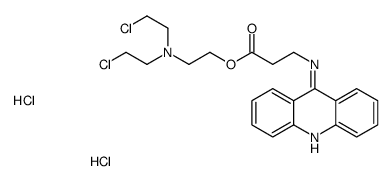210584-54-6
| Name | 2-[bis(2-chloroethyl)amino]ethyl 3-(acridin-9-ylamino)propanoate,dihydrochloride |
|---|---|
| Synonyms |
Amustaline Dihydrochloride
Amustaline HCl S-303.2HCl UNII-C5MKX7XOYA S 303 dihydrochloride |
| Description | Amustaline (S-303) dihydrochloride, a nucleic acid-targeted alkylator, is an efficient pathogen inactivation agent for blood components containing red blood cells. Amustaline dihydrochloride has three components: an acridine anchor (an intercalator that targets nucleic acids non-covalently), an effector (a bis-alkylator group that reacts with nucleophiles), and a linker (a small flexible carbon chain containing a labile ester bond that hydrolyzes at neutral pH to yield non-reactive breakdown products)[1][2]. |
|---|---|
| Related Catalog | |
| In Vitro | S‐303 (200 μM; 20 h) and glutathione (GSH; 20 mM) inactivates high titres of Chikungunya virus (CHIKV) in red blood cells (RBCs)[1]. S-303 (200 μM; 20 h) and GSH (2 mM) inactivates >6.5 logs of HIV, >5.7 logs of Bluetongue virus, >7.0 logs of Yersinia enterocolitica, 4.2 logs of Serratia marcescens, and 7.5 logs of Staphylococcus epidermidis in whole blood experiments[2]. S-303 (200 μM; 20 h) and GSH (20 mM) inactivates approximately 5 logs or greater of Y. enterocolitica, E. coli, S. marcescens, S. aureus, HIV, bovine viral diarrhoea virus, bluetongue virus and human adenovirus 5 in RBC[2]. S-303 (200 μM; 20 h) retains in vitro parameters of RBC function and physiology (including total ATP, extracellular potassium, hemolysis, glucose consumption, lactate production, and pH at 37 °C) compared to conventional RBC[2]. |
| In Vivo | S‐303 RBCs (a single transfusion) is well tolerated in rats (50 μmol/kg) and dogs (70 μmol/kg)[3]. S‐303 RBCs (repeated transfusions) is well tolerated in rats (10 μmol/kg) and dogs (10 μmol/kg) with no histopathologic evidence of organ toxicity[3]. |
| References |
| Boiling Point | 575.2ºC at 760 mmHg |
|---|---|
| Molecular Formula | C22H27Cl4N3O2 |
| Molecular Weight | 507.28100 |
| Flash Point | 301.7ºC |
| Exact Mass | 505.08600 |
| PSA | 57.69000 |
| LogP | 5.53870 |
| Vapour Pressure | 3.1E-13mmHg at 25°C |
